Top Seven Success Factors for Value Creation
Gene Tyndall
EVP
Tompkins International
www.tompkinsinc.com
Doug Kane
Industry Partner, HighTech and Manufacturing
One Network
www.onenetwork.com
September 2012
Introduction
Senior executives at topperforming companies in the hightech industry realize that optimizing supply chain operations is directly correlated with profitable growth, higher operating margins, and capital efficiency – each of which helps create value. They also realize that optimal supply chain operations provide their companies a significant competitive advantage and differentiation.
This is becoming more and more obvious. In 2012, the Gartner Supply Chain Top 25 named eight high tech companies among the 25; Apple was again named #1. Several more are included in the Top 50.
The fact is that highperforming supply chains – from suppliers’ suppliers to customers’ customers – are playing a major role in not only dealing with today’s economies, but also enabling companies to create increased value.
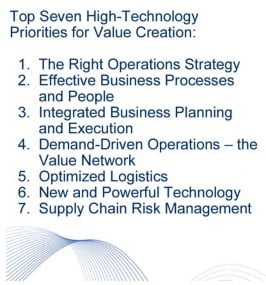
Tompkins International (a highly recognized global supply chain consulting firm) has teamed with One Network (a leading IT solutions provider of RealTime Value Networks) to develop the top seven priorities that leading hightech companies adopt as their improvement agendas. This paper is a jointly produced guide for all hightech managers who want to follow the right path, using the right solutions, to achieve highperforming supply chains.
The goal of reaching “optimum supply chain operations” – and therefore highperforming business results – is achievable and is proven to be well worth the investments to get there.
The seven top priorities are as follows:
-
The Right Operations Strategy
-
Effective Business Processes and People
-
Integrated Business Planning and Execution
-
DemandDriven Operations – the Value Network
-
Optimized Logistics
-
New and Powerful Technology
-
Supply Chain Risk Management
Each priority is discussed here. The paper also includes guides, solution opportunities, and insights from the collective experiences of Tompkins International and One Network. The objective is to provide high tech executives advice as they progress through the path to Supply Chain Operational Excellence.
Priority #1: The Right Operations Strategy
All executives are familiar with business strategy – determining target markets; deciding on products and services to sell to those target markets, along with the respective value propositions; and, the capabilities needed to deliver those products and services. Deciding on markets, products, and services, and why customers will buy, are strategic and difficult choices.
Determining the right operations strategy is no easier. Deciding how to provide the needed capabilities, where, when, why, and by whom, is equally challenging. As supply chain managers know, there are multiple ways to organize and flow goods, information, cash, and work, from endtoend for each supply chain or product category. Sourcing, producing, delivering, and so on, are replete with options.
Optimum supply chain operational performance must be driven by the right operations strategy for each particular company, as well as the market segments it serves. Without a coherent operations strategy, any company runs the risk of optimizing the wrong areas, whether they are addressed as costs or services.
As shown below, the Gartner Supply Chain Maturity Model, with its four stages, illustrates this concept.
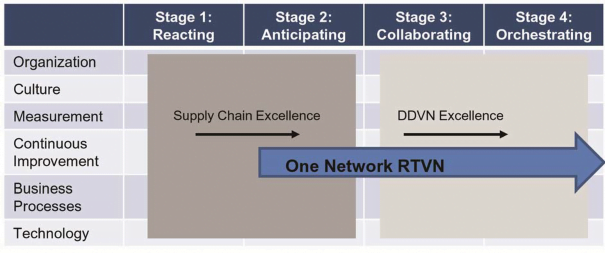
In this model, Supply Chain Orchestration (stage 4) is considered to be optimum. Orchestration refers to the capability to be a chain leader to lead the planning and execution according to customer needs. In the hightech world, orchestration of a company’s supply chain has largely been less than that of the consumer product goods (CPG) or retail leaders. In effect, the brand owner company has dictated the needs and the ways in which the supply chains would react. This has often resulted in supplier problems, component shortages, and higher costs than necessary.
Note that the transition from Supply Chain Excellence to DemandDriven Value Networks is the critical success factor for reaching the capability to “orchestrate” the supply chains. This capability involves maximizing the value across the set of business processes and technologies that “sense and orchestrate” demand, based on a “nearzero latency signal across multiple networks of people and trading partners,” according to Gartner. More on this strategic principle later.
Deciding on the right operations strategy revolves around the type of company that its executives want, along with the performance goals they set. Focusing on operating costs, or customer needs, or service levels, or a continuous flow of new product, or operational innovations, are all strategic choices first.

As mentioned earlier, there are multiple ways to enable business strategy. The critical success factor in doing so is defining the operations strategy that performs that best – from the perspectives of profitable growth, operating margins, and the efficiency of capital employed.
At the heart of defining the right operations strategy is the development of the optimum network facilities and flows of goods, information, cash, and work.
Network planning – deciding how the network will be designed – is best based on the evaluation of alternative scenarios. For this, there is no substitution for the intelligent application of a network optimization model. Once the operations strategy and network design is in place, the hightech company can progress through the remaining priorities.
Priority #2: Effective Business Processes and People
There are several business processes that drive supply chain operations for hightech companies. There are more than 20 within the following categories:
-
Overall Supply Chain Processes – such as S&OP, Performance Management, Risk Management.
-
Demand Planning and Execution
-
Supply Planning and Execution
-
Logistics and Network Planning and Execution.
Each of the 20 or so processes within these categories is a candidate for process improvement. Adapting leading practices, applying sound technology, and encouraging innovation are often used to improve the productivity, costs, speed, and output for any business process. Outsourcing in some cases may also improve certain processes. The keys to process improvement are to: (1) understand and map the current process sufficiently to measure its cost, time, and quality; (2) find better ways to achieve the needed objectives; and (3) test potential options and implement with change management methods.
Better ways to conduct processes are always being developed. As hightech companies continue to face increased global competition and decreased product lifecycles, the speed in which the supply chains can react is critical. Within any industry’s maturity cycle, process automation (or at least, process support) has always been critical in achieving efficiencies required to compete or provide competitive advantage.
With supply chain operations performance continually increasing its influences on competitive differentiation and as a critical component to shareholder value, it only makes sense that each company will need to leverage the right technology for process improvement. A hightech company that avoids this progression and continues to require its planners and managers to operate on Excel spreadsheets to find answers to supply chain problems that are changing in real time will fall too far behind.
Change Management
The management of change is difficult. Several hightech companies have declared their interest in supply chain transformation. Out of this interest, the most common questions include: How do we transform my current supply chain operations into sustainable performance? What should be the outcome of the transformation? What processes should be changed first? How should the different functions and processes be aligned within our organization so that they are all working optimally to ensure increased business value? Some of these questions unfortunately go unresolved and transformations are not completed or satisfying.
The Tompkins/One Network team has helped several companies define their supply chain transformations, as well as new organizations and processes, and assisted with change management. Through knowledge of the industry and relevant experience, process improvement methods are developed that work well for hightech companies.
The Real Cost of Performance Incentives
One of the key process issues is associated with performance incentives, which may be in direct conflict with the fundamental objective of maximizing business value. For example, in some cases, the general manager of a production facility is incented to ensure the factory is running at full capacity, with little regard to its producing only finished goods that are assured of being sold. When sales forecasts are so unreliable and forcing sales for the wrong products is more and more challenging in today’s economy – there are avoidable conflicts.
As another example, many times incentives to reduce freight costs conflict with incentives to reduce inventories. Such incentives to optimize an individual operation’s efficiency are usually put into place with the best intentions. Yet, the results are governed by the law of unintended consequences that typically produce suboptimal results; or worse, they produce results that are counterproductive or polar opposite to the original intent.
A hightech company can have the most efficient operations within each functional silo yet create a result that is counterproductive to the organizational goal of maximizing overall business value. Since supply chains are really a community of trading partners, and their overall performance is dependent upon one another, then Supply Chain Orchestration is required to achieve true value. This, then, depends on supply chain processes that foster collaboration and people that are have incentive to work together for the common good.
Developing and Maintaining Supply Chain Talent
An active discussion topic today is targeted at the availability of supply chain talent. It is, of course, very important to have highly skilled people with the right incentives and right tools in order to maximize the company’s value. As the importance of supply chains to hightech companies has expanded significantly, nearly 50% of all companies have appointed a Chief Supply Chain Officer (CSCO). This action alone has helped not only the company, but also the profession, as more talented people see the CSCO as symbolic with importance.
Further, with the incredibly short life cycles of many hightech products, long lead times from suppliers, and an increasingly fickle consumer base, hightech companies realize more and more that they must optimize their supply chain operations around speed and agility if they have any chance of staying competitive or achieving reasonable profits and growth. By either proper retraining, or replacement, an increasing number of highly educated and trained supply chain professionals are using the latest technology available in order to ensure speed, agility, and efficiency of operations.

In addition to developing talented supply chain people, there is a growing need to do a lot more with a lot less. The only way to achieve scale, while producing higher levels of performance, is by the smart application of new technologies. The remaining five priorities require this strategy in order to reach the goal.
Priority #3: Integrated Business Planning and Execution
Demand and supply planning, and its inherent sales and operations planning (S&OP) process, is well known to most hightech companies. The need to forecast sales is critical for BUYING, MAKING, MOVING, STORING, and SELLING the right components, products, and services to customers, regardless of what or to whom. Yet, it is commonly known that forecast error is prevalent, no matter whether the product is made to stock or to order. Even when made to order, the long lead times with hightech components have made it impossible to produce on a timely basis without more accurate sales forecasts.
Most hightech companies have worked on improving their forecasts. They have worked on this with the help of implementing ERP systems, point solutions, or both. They have also established better processes for who should be involved, how forecasts should be developed, reviewed, and approved, and the sign off procedures. However, not many have made much progress in collaboration across their supply chains and into what is referred to as integrated business planning and execution.
Technologies, to date, have been of incremental help, but none has delivered the promises of full visibility, near realtime information, near realtime automated response, and endtoend supply chain integration. Now, new technology is available that does just that.
Many companies have preferred to wait for quality tools to be developed, tested and proven. This “wait and see” attitude toward adopting SaaS and Cloudbased applications for their core business operations has caused many to fall behind, while staying with older systems. The One Network solution is designed to operate in the value chain (or value network) of all the companies consisting of a community of trading partners, both on the supply side and on the demand side.
Since companies exist within a complex set of interconnections in their value network, it makes sense that the pointtopoint communication send/receive models (such as EDI) as the most efficient methods of sending/receiving/accepting purchase orders will be replaced with the much more efficient near realtime model for communicating among trading partners.
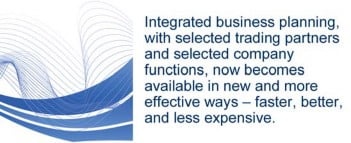
The Power of the Cloud
The power of the Cloud is evident in daily activities. Social media, such as Facebook, have shown everyone the power of Cloud computing. The posting of any change is instantly seen by anyone on a user’s network who has been given the permission to view that change.
Similarly, with this solution, a company and all of its supply and demand trading partners simply add their “profile.” Then, the company grants permissions for what information others can view. This allows trading partners to have instant access to changes in data and gives them the ability to execute and re optimize their value networks on that change data.
Further, a supply chain function can now easily decide which applications it would like to run, and when. This not only allows the company to deploy applications more quickly, resulting in faster time to value, it also can enable rapid and easily defined steps that provide incremental value. This is in direct contrast to the large, monolithic, and onpremise installations of ERP that were architected in the 1990s with focus on financial and material flows within the four walls of the enterprise.
So, integrated business planning, with selected trading partners and selected company functions, now becomes available in new and more effective ways – faster, better, and less expensive. This can be done locally, with one product category, or globally with all categories. As one CEO chose to refer to his company’s S&OP (IBP): “It is a Global Planning System (GPS).”
Priority #4: Demand-Driven Operations – The Value Network
The hightech world has evolved from the early days of predominantly maketoorder to the current times of customer and consumer power. Of course, new and innovative products are valuecreating when they create demand. Whether sold through retail channels, or to commercial accounts, or direct to consumers, the volatility of demand has impacted nearly all hightech companies.
Thus, changes in operations strategies favor more of a focus on demanddriven operations and practices. The “pull” model has been overtaken by a “pushpull” operations strategy that must deal with more than sales forecasting. It must redirect supply chain attention from focusing 90% on the supply base to more than 50% on the demand side, with the proper mix depending on the product and its reliance on special components.
Demanddriven supply chains are those that start with the SELL (customer’s customer) and work backward to the BUY (supplier’s supplier). Of course, this requires new technologies as well as new processes, and new mindsets. The value creation potential, however, is significant, as profitable growth, operating margins, and capital efficiency are all impacted positively. And, free cash flow – the ultimate creator of value – is increased, due to lower costs, less inventories, and greater speed.
As with integrated business planning, the availability of new technology that is Cloudbased and is designed for the “near realtime” operations is changing the way in which endtoend supply chains can work. This technology enables: (a) POS data to be captured; (b) forecasts to be updated continuously by aligning the variable demand and then shared in near realtime; and (c) supply chain trading partners to react within in near realtime, instead of over weeks.
The fundamental value and differentiating principle of hightech companies – speed to market – is now a reality. The original operations concept of “sell one, ship one, make one” is now a reality. And, the transformation of “supply chains” to “demand chains” is also a reality.
A further point has to do with enhancing the company’s ERP system, should it have one. The RealTime Value Network (RTVN) provides a realtime planning and execution layer that spans across multiple enterprises of trading partners. This not only allows simultaneous visibility of what is happening throughout the endtoend chain; it also, when integrated with the ERP systems of those in the chain, provides these systems with data that is much closer to real time. Thus, the information is more accurate as to what is actually occurring.
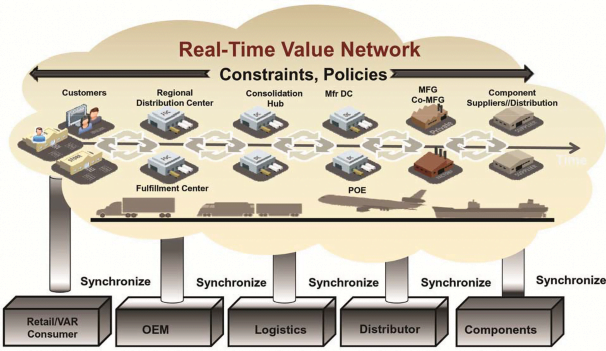
This also emphasizes the reality of visibility. Demanddriven operations require that all trading partners have ready access to supply chain visibility – visibility to what goods are sold, planned, produced, stored, intransit, and returned, all through the endtoend value network. This longexpressed goal of supply chain managers is now a reality. They have views that are shared in realtime with all partners. When the right applications are added to this, important events occur, and highperforming supply chains result.
Of course, visibility throughout the entire supply chain is the key to action, but by itself it is not enough. True supply chain velocity is derived from sensing a change, evaluating the impact of that change to every other point in the chain, and then responding optimally for every point in the chain. The faster any supply chain can sense, evaluate, and respond to a realtime variation from the “plan,” the more value can be created.
One Network is the first to provide this complete solution – from visibility to optimal automated response. Many software systems now provide improved visibility, and even realtime alerts. However, the company must then decide what actions to take from the alerts (and sets of a series of manual processes that introduce response latency and increased likelihood for errors). They also must determine whether any action will adversely affect another supply chain trading partner. In a complex supply chain, with multiple interconnections among demand and supply, it is no simple matter to decide what to do with a variation or variability.
Alternate suppliers, alternate routings, alternate transport carriers, and alternate stocking points all must be evaluated. Their availability, their capacity constraints, and their costs to serve are a few factors to be considered. With the multitier, multienterprise One Network RTVN, these alternate evaluations, and their optimal solutions, are developed almost instantaneously. The automated response to the sensing is assured and provided in near realtime. This is a new and powerful set of tools to the supply chain manager.
Thus, demanddriven operations become a reality. Realtime sense and respond enables the path to supply chain orchestration, and the competitive advantage that comes with it, as shown in the following Supply Chain Maturity graphic.
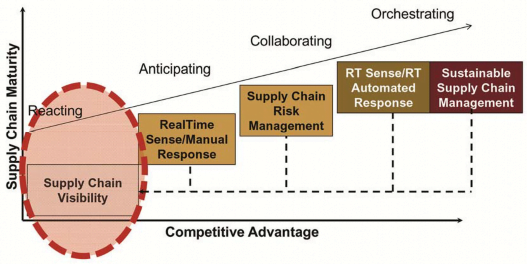

Reaching the optimum stage of supply chain maturity – the ability to lead the complete supply chain to act in unison with “one version of the truth” – starts with visibility, proceeds through realtime sense and automated response, and continues to optimal execution.
Priority #5: Optimized Logistics
The operations of the flow and storage of goods and components in the hightech world are highly important. Higher costs of global sourcing and serving global markets play a part. But, at the same time, having the right product in the right place, in the right amounts, and at the right time, is necessary for growth. The longer lead times for components and supplying finished goods – whether to more demanding customers, to more multichannel markets, or to emerging growth markets – require even more intelligent logistics than was needed 10 years ago.
There are numerous opportunities within the endtoend supply chain to optimize logistics. This is normally achieved by minimizing the total costs while meeting customer service requirements. The primary needs are the inbound flows of materials, the outbound flows of semifinished goods and finished products, the storage of product in the right facilities, and the deliveries of products to customers or consumers.
The “cost to serve” represents the total costs of providing the product to retailers, wholesalers, and direct to consumers. Eighty percent of this is reflected in logistics: freight, distribution, returns, refurbishing, and packaging, as well as the support services that enable these functions. If the cost to serve a customer is not competitive, the brand owner faces a loss in sales and profitability.
In addition to forward logistics, there also are returns, repairs, recycling, and disposal logistics to manage. The innovative value network technology supports the reverse logistics process as well. It tracks the SKU, routes it according to predetermined business rules, and minimizes the total costs of doing so. Reverse logistics in the hightech world are very important. Innovative technology, together with leading practices, can optimize this business process as well.
As before, having total supply chain visibility, and near realtime automated optimal response, enables logistics managers to apply the right tools to MOVE, STORE, and SELL the products with the optimized costs and service levels.
Whether purchase orders are for replenishment, or for new or special products, logistics operations provide the essential data for analyses and plans that minimize the costs and maximize the service. The accommodation of reverse logistics for returns, repair and refurbishment, recycling, and disposal, adds to the complete product life cycles. Total logistics management can be optimized with the complete supply chain software solution.
Priority #6: New and Powerful Technology
New and innovative technologies are key priorities for hightech supply chains to reach optimum levels of performance and to achieve the supply chain orchestration level of maturity. One Network has developed this technology, and it is being proven at many companies to deliver dramatic new levels of operating performance.
This new technology has several important differentiating features:
-
It operates in the Cloud, as Software as a Service (SaaS). Thus, unlike major system implementations that require many months or years, it can be put in place in a few months. Further, since it is available ondemand, it is less expensive than major systems. And, it can be readily changed to adapt to the company’s business rules. At the same time, unlike monolithic, inside the four walls software solutions, such as ERP, the Cloud provides the perfect architecture for multienterprise solutions, which are inherent in the supply chain world.
-
It is based on a single platform that is made available to all the trading partners in the value network. No more timing challenges with delayed EDI systems, integration problems, or delayed file transfers. All trading partners are operating on the same posted data across the value chain and integrated into the multienterprise, manytomany network IT architecture.
-
As it deals with order and product flows, it enables numerous points for optimization all along the supply chain. Any action taken at one of these points may impact the others, often adversely. One Network’s system evaluates each point and automatically responds with an optimal total supply chain solution based on cost within the necessary lead time.
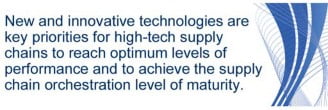
Currently, there are thousands of companies on the network. Client companies implemented thus far have brought thousands of suppliers onto the system. More are being added monthly.
-
Unlike an ERP, it can be implemented in a few months, used as needed, scaled as needed, and changed as needed. As stated previously, the time to benefit is greatly reduced. No more months of waiting for IT changes to catch up to market changes or needs.
-
It integrates with the company’s ERP, or other enterprise systems, to improve results and operating performance. There is no need to replace a system; rather, it enables them to run better. Integrations with ERP or other production systems are relatively straightforward.
-
The architecture supports multiparty, multitier, manytomany environments. The complete supply chains for hightech companies are often multiechelon and multitiered, and all are manytomany. One Network does this more readily than any other applications software, and it is the only manytomany network architecture commercially available.
-
It provides near realtime sense and respond. This refers to more than realtime visibility. It evaluates alternatives and derives the optimal automated responses.
-

It provides a painfree, rapid onboarding process. In order to evolve in supply chain maturity to stage 3 collaboration and stage 4 orchestration, it is critical to be able to “onboard” trading partners (both supply and demand) quickly and easily if they are not already on the network. With the One Network architecture, customers and suppliers are able to access the network within a day and immediately begin to conduct business with your company.
-
The solution enables improved collaboration with all partners in the supply chain. This includes real time visibility as well as the capabilities to plan, execute, respond to variations, and learn in unison.
-
It does not rely on sales forecasts; rather, it updates them continuously. Its continuous forecast management (CFM) feature means anyone across the value network can view an updated forecast in as few as 15 minutes.
-
It enables the use of business intelligence and business analytics for operations excellence. Near realtime data, turned into information and decisionmaking, is the best possible business intelligence and provides the best possible analytics. These are current, factual, learned, and proven to the company. When used in the context of benchmarking and best practices (as provided by Tompkins Supply Chain Consortium), BI/BA provides companies much more than information. It enables managers to make informed decisions that impact key performance measures that are relevant to industry companies and customers.
-
It yields supply chains with lower costs, maximum service levels, higher inventory turns, and other performance levels that were previously unachievable. The performance results achieved thus far are way beyond those experienced by any company to date. Some are at the theoretical minimums on lead times, turns, lowest possible costs, and optimum service levels.
These factors, taken individually or together, illustrate the power of this new technology to enable increased shareholder value, higher customer satisfaction, and maximized profitable growth. No IT system to date has been able to achieve these levels of business performance results.
Priority #7: Supply Chain Risk Management
As supply chains have become more global, companies have been exposed to more risks. These risks may have been induced by extreme weather events, labor disruptions, terrorist actions, supply shortages, human error, technology failures, infrastructure breakdowns, or poor sales forecasts.
The normal response to risk mitigation is to design backup contingency plans. However, these scenarios are too often based on theory and not reality. Because the “perfect information” in any given supply chain is elusive; the plans are based on “old news” and may not be doable when the disruption occurs. Further, inasmuch as the trading partners are not included in the contingencies, problems surface that were simply not expected.
By providing near realtime information on the operations of the supply chain, the technology of One Network makes risk mitigation much more manageable. First, the optimization engines and value chain modeling capability allow companies to plan alternatives, so that immediate rerouting or reservicing actions can be taken in the event of a supply chain disruption. Second, the automated response to real time data permits will reoptimize the value network in near realtime in the event that a disruption of any kind occurs.
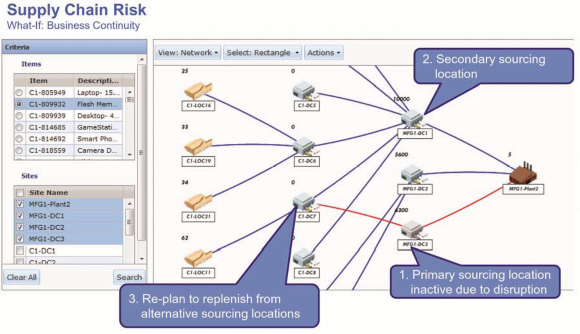
Conclusion

These seven top strategic operations priorities for hightech companies are actively being pursued by the leaders in various hightech segments. Those on top want to remain as leaders in the industry, and others want to achieve the optimum maturity model: Supply Chain Orchestration.
Guidance through the path, and assistance with effective new business processes and technology implementation, is provided by the Tompkins/One Network team. Catapulting hightech companies to competitive leadership, as well as value creation, is the team’s goal.
Contact Tompkins/One Network to discuss how to implement these new and exciting solutions at your company. Organizations in the hightech industry are undergoing competitive pressures and customer demands for not only new products, but also for innovative sales channels and services.
RealTime Value Networks are now a reality. The advanced technology, together with our knowledge of effective processes and their benchmarked leading practices, are combining to yield performance results previously thought to be unattainable. Every hightech company should take advantage of this integrated solution to achieve Supply Chain Excellence and leadership in its markets. The time is now.
About Tompkins International
Tompkins International transforms supply chains to help create value for all organizations. For more than 35 years, Tompkins has provided end-to-end solutions on a global scale, helping clients align business and supply chain strategies through operations planning, design and implementation. The company delivers leading-edge business and supply chain solutions by optimizing the Mega Processes of PLAN-BUY-MAKE- MOVE-STORE-SELL. Tompkins supports clients in achieving profitable growth in all areas of global supply chain and market growth strategy, organization, operations, process improvement, technology implementation, material handling integration, and benchmarking and best practices. Headquartered in Raleigh, NC, USA, Tompkins has offices throughout North America and in Europe and Asia. For more information, visit www.tompkinsinc.com.
About One Network Enterprises
More than 30,000 companies are already connected to the RTVN for demand driven services that have repeatedly proven to lower inventories and operational costs, improve service, and increase profitability-Kroger, Lockheed Martin, Imperial Logistics, the US Department of Defense, Del Monte Foods, the US Marine Corp, and many others- are becoming demand driven with One Network’s RTVN. Headquartered in Dallas, Texas, One Network also has offices in Europe and India. For more information, please visit www.onenetwork.com.
Contact
Gene Tyndall
EVP
Tompkins International
gtyndall@tompkinsinc.com
Doug Kane
Industry Partner, High-Tech and Manufacturing
One Network
dkane@onenetwork.com


